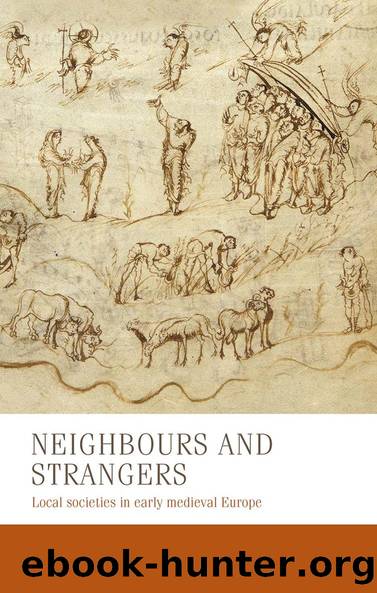Neighbours and strangers by unknow

Author:unknow
Language: eng
Format: epub
Tags: History, Europe, Medieval, Social Science, Archaeology, Social History
ISBN: 9781526139832
Google: IKLYDwAAQBAJ
Publisher: Manchester University Press
Published: 2020-03-24T00:36:32+00:00
6
Interventions in local societies: lower office holders
Local societies were not independent of their surroundings in most parts of western Europe in the early Middle Ages, perhaps with the exception of some very localised regions in northern Iberia. Most âsmall worldsâ belonged to regional or supra-regional networks and structures. Office holders and agents â ranging from mayors and priests to bishops, counts, viscounts and centenarii (hundredmen) â intervened in local affairs for landowners, kings and other lords they represented. Since kings, powerful lay aristocrats and religious institutions had large scattered land holdings in many regions, even those lords who were involved in macro-politics might be neighbours in small settlements, allowing us to see them both as outsiders to local society and as insiders.
The following two chapters treat the question of how outside interventions influenced local practices. In this chapter we will discuss the ways in which secular office holders, especially lower office holders, were present and how they acted within local society. Chapter 7 will change the perspective: in it, we will focus on other kinds of outside intervention. We will leave divine interventions aside â an accepted part of life in the early Middle Ages, but in quite a different way from those of that chapter.
Here, we will understand as office holders persons charged with certain tasks and given a certain authority, conferred on them â at least in theory â by a higher authority, marked with a title and held for a certain period of time. Lower-level secular office holders of this type are found in all the regions treated in this book, with the possible exception of northern Iberia. We will begin with a survey of cases from the regions treated here to illustrate the scope of office holdersâ titles, activities and interventions. After this, we will discuss the social background of the office holders and the question of access to office. Since intervention in local societies necessarily involved outside authorities, we will then turn to the ways in which kings used norms to influence lower-level office holders.
In what follows, we will treat both office holders from the âpublicâ and âprivateâ sphere. This modern distinction between public and private is entrenched in scholarship but was much more blurred in the perception of contemporaries; it is therefore not especially helpful as an analytical distinction in the study of power structures (especially in those regions in which there were either no or weak central powers). We have to take all types of intervener in local society into account, such as those acting as administrators of large-scale land holdings or advocates serving as legal representatives for clergymen and women. Some, but by no means all, of these ânon-publicâ interveners were probably much more local in their spheres of action than those who held an office that was controlled by a king.
Distinguishing between âsecularâ and âclericalâ office holders â the subject of Chapter 5 â is in some ways easier, because the distinction was clearly perceived by contemporaries, but this is not clear-cut either.
Download
This site does not store any files on its server. We only index and link to content provided by other sites. Please contact the content providers to delete copyright contents if any and email us, we'll remove relevant links or contents immediately.
Technical Art History by Jehane Ragai(456)
Art, Science, and the Natural World in the Ancient Mediterranean, 300 BC to AD 100 by JOSHUA J. THOMAS(410)
Graphic Culture by Lerner Jillian;(397)
The Slavic Myths by Noah Charney(369)
Pollak's Arm by Hans von Trotha(340)
Simply Artificial Intelligence by Dorling Kindersley(337)
Treasuring the Gaze by Hanneke Grootenboer(337)
Sketchbook Confidential: Secrets from the private sketches of over 40 master artists by Editors of North Light Books(337)
The Art of Portrait Drawing by Cuong i(331)
Drawing for the Soul by Zoë Ingram(328)
Drawing Landscapes by Barrington Barber(320)
Mountain Manâs Field Guide to Grammar by Gary Spina(312)
The Art of Painting Sea Life in Watercolor by Maury Aaseng Hailey E. Herrera Louise De Masi and Ronald Pratt(310)
Portrait of a Woman by Bridget Quinn(300)
Anatomy for the Artist by Jennifer Crouch(293)
A text-book of the history of painting by Van Dyke John Charles 1856-1932(288)
Preparing Dinosaurs by Wylie Caitlin Donahue;(281)
Botanical Illustration by Valerie Price(280)
Egyptian art by Jean Capart(277)
